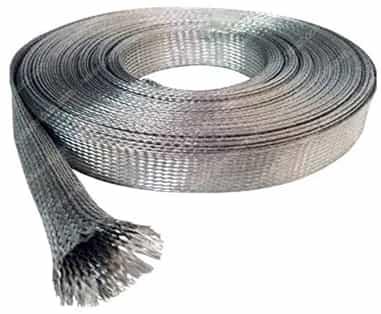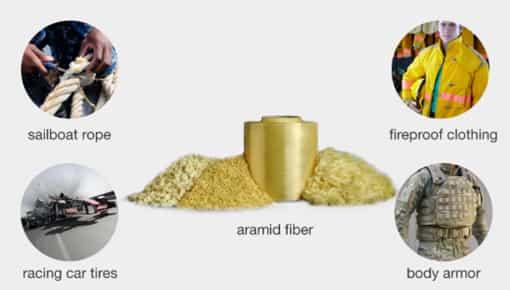EMI Shielding:Metal Braid vs Metal Clad Aramid Fiber
Advertisement
Introduction : Electromagnetic Interference (EMI) shielding is the practice of protecting sensitive electronic components from interference caused by external electromagnetic fields. This is typically achieved by enclosing the components in a conductive material, which creates a Faraday cage that blocks or redirects the interfering energy. In this page, we will understand two primary methods of EMI shielding for cables and harnesses viz. traditional metal braids and metal clad aramic fibers and explore differences between them.
Metal Copper Braid : Key Advantages & Disadvantages
This method is in use for decades. It involves weaving strands of conductive metal, most commonly copper or tinned copper, into mesh like tube that covers underlying cable. This is shown in figure-1.
Advantages of Copper Braid
Following are some of the benefits of copper braid.
- The manufacturing processes for copper braids are well established and widely available, making them a reliable and low cost solution.
- Copper is an excellent conductor, making it very effective at shielding, particularly at lower frequencies.
- The braided structure provides good physical protection and redundancy, as multiple current paths are available even if some strands fail.
- The procedures for installing and terminating traditional braids are straightforward and generally only require basic tools.
Disadvantages of Copper Braid
Following are some of the drawbacks of copper braid.
- Copper is a dense material (approximately 8.96 g/cm^3). In modern applications, especially in aerospace and defense where every gram matters, this high weight is a significant drawback.
- Copper braids exhibit “mechanical memory,” meaning they tend to hold their shape after being bent. This rigidity can create stress on the underlying conductors, restrict design flexibility in tight spaces, and potentially shorten the system’s lifespan in dynamic environments.
- At higher frequencies (in the GHz range), the small gaps or “apertures” in the braided structure can allow EMI to penetrate the shield. This phenomenon, known as “windowing,” reduces the shielding effectiveness.
- In harsh environments, such as naval applications with salt spray and humidity, copper braids are prone to corrosion, which can degrade their performance over time.

Metal clad Aramic Fiber : Key Advantages & Disadvantages
Advantages of Metal clad Aramic Fiber
Following are some of the benefits of Metal clad Aramic Fiber.
- By using a polymer core, these composite materials offer exceptional strength to weight ratios (aramid fiber is about five times stronger than steel by weight), leading to significant weight savings.
- The polymer core is highly flexible and does not have the “mechanical memory” of metal. This allows for easier routing in complex geometries and dramatically increases the flex life of the cable.
- The ultra fine filaments of the composite material can be packed more densely than traditional braids. This increases the surface area and reduces the size of the apertures, enhancing shielding effectiveness at high frequencies.
- The polymer core is inherently resistant to corrosion, making these materials ideal for harsh naval or industrial environments. They also exhibit more stable performance across wide temperature ranges.
- These materials can be engineered to have very low outgassing properties, meaning they don’t release gases in a vacuum that could contaminate sensitive optics, making them perfect for space applications.
Disadvantages of Metal clad Aramic Fiber
Following are some of the drawbacks of Metal clad Aramic Fiber.
- The advanced materials and specialized manufacturing processes such as plating polymers generally make composite solutions more expensive than traditional copper braids.
- While not explicitly detailed as a disadvantage in the article, these advanced materials may require different and more specialized termination and handling techniques compared to the simple crimping or soldering of copper braids.

Key differences
| Feature | Traditional Metal Braids (Copper) | Advanced Composite Shielding |
|---|---|---|
| Weight | Heavy | Very lightWeight |
| Flexibility | Rigid, retains shape | Highly flexible, long flex life |
| High Frequency Shielding | Less effective due to windowing | More effective due to denser packing |
| Corrosion Resistance | Prone to corrosion in harsh environments | Inherently resistant to corrosion |
| Cost | Low, cost effective | Higher initial cost |
| Primary Application | Legacy systems, cost-sensitive projects | Modern aerospace, defense, space and high performance electronics |
Conclusion: Overall, metal braid shielding remains ideal for high performance, high durability EMI protection, whereas metal clad aramid fibers represent a next generation alternative optimized for lightweight, flexible and corrosion resistant designs. The optimal choice ultimately depends on the balance between shielding effectiveness, mechanical requirements, environmental conditions and system level design priorities.
Advertisement
 RF
RF





